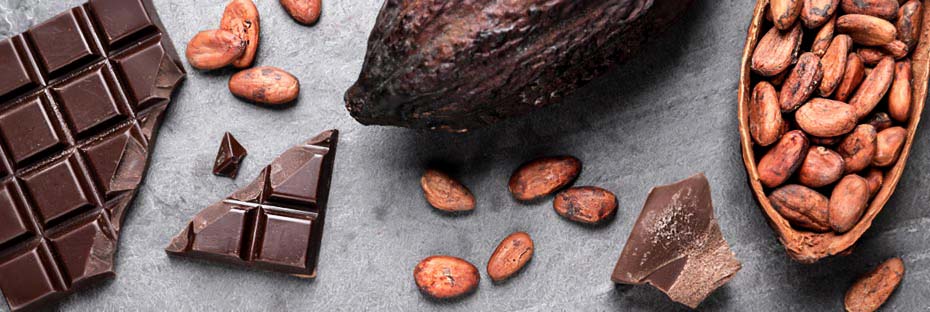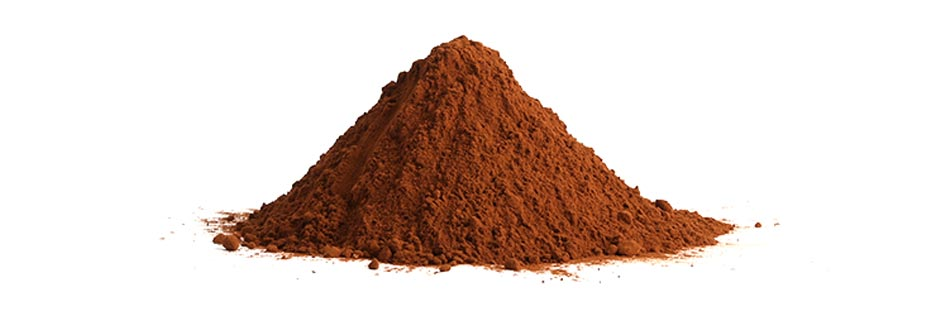Cocoa flavanols: the definitive guide

Author Miriam Ferrer, PhD Last updated 18th November 2019
- Ingredients & Nutrition
Flavanols are naturally occurring plant-based nutrients that have antioxidant properties. They are found in many common foods, including tea and various fruits, but cocoa contains a unique blend that is known to have a positive effect on blood circulation.
- What are cocoa flavanols?
- What are the effects of cocoa flavanols?
- Why is blood vessel elasticity important?
- How do cocoa flavanols help?
- How common are circulation problems?
- Foods rich in cocoa flavanols
- Are cocoa flavanols safe?
- How much cocoa should I eat?
- Summary
What are cocoa flavanols?
Cocoa flavanols are found in the seeds of the cocoa tree (Theobroma cacao), which is native to South America. The flavanols in cocoa are responsible for the bitter taste of dark chocolate.
They are part of a group of organic chemicals found in plants called polyphenols, which perform a range of functions including protecting them from UV radiation. In humans, research suggests that polyphenol intake is associated with a reduced risk of chronic diseases.1

The cocoa tree originates somewhere East of the Andes, and has been cultivated by humans for nearly 4,000 years. In native South and Central American cultures its seeds were dried and then used to create drinking chocolate, which was often reserved for royalty, the priesthood and aristocracy and forbidden to women and children.
Drinking chocolate played a role in religious ceremonies among the Olmecs, Toltecs and Maya. The Aztecs placed such a high value on it that they believed the god Quetzalcoatl stole the cocoa tree from his brother and presented it to humans as a great gift.
Cocoa products were also consumed as a medicine. Spanish sources from the age of discovery and conquest report that it was used to treat everything from minor complaints like fatigue, constipation and digestive discomfort to debilitating illnesses like liver disorders, gout, angina and dysentery.2
First transported to Spain in the 16th century, chocolate was initially used as a medicine in Europe thanks to rumours that it was used as a treatment by native Americans. This helped to balance Christian suspicion of new luxuries like coffee and chocolate, which were fears its stimulating effects would encourage immorality.

Early Modern doctors classified chocolate according to their traditional understanding of medicine, which went back to the ancient Greeks. From its discovery by Europeans to the 19th century it was usually suggested that chocolate could improve digestion, stimulate the nervous system, help patients to gain weight and act as an aphrodisiac.3
Outside of the medical sphere, chocolate quickly became a popular beverage when sweetened with spices and sugar. Cocoa was eventually cultivated and imported to Europe in larger quantities, while the industrial revolution brought new technologies for mass production. These changes made cocoa an important consumer good. Today, millions of tons of cocoa beans are consumed every year.
Recently, scientists have taken another look at the medicinal history of chocolate, looking for reasons why it might have been seen as an effective treatment. There has been much focus on the health benefits of a particular component, cocoa flavanols, since the year 2000. Numerous studies have shown that daily consumption can have health benefits.
What are the effects of cocoa flavanols?
Research suggests that cocoa flavanols can have a positive effect on cardiovascular health, specifically blood vessel health and circulation.
The human body contains 60,000 miles of blood vessels - from large arteries and veins to tiny capillaries.4 These vessels allow for the efficient movement of vital nutrients and oxygen to every cell. Keeping them healthy is important for your general health - for example, good blood flow allows your extremities to stay warm and helps your skin and brain to function properly.5, 6
Unfortunately, blood vessels can be damaged by a whole range of factors including pollution, poor diet, obesity and smoking. These can cause conditions like atherosclerosis, a hardening of the blood vessel walls that makes it more difficult for the body to regulate blood pressure and normal flow.
Cocoa flavanols can have the beneficial opposite effect, as they can increase the elasticity of blood vessels. It is not yet clear the mechanism of action by which they achieve this effect, but researchers agree that it is likely they increase the production of nitric oxide by the body.7 Nitric oxide is a molecule produced by our body, which among other functions, is responsible for relaxing the walls of the blood vessels and improving blood circulation.8
Some studies - for example, a study looking at population-level blood pressure changes among groups native to Central America who move from traditional to modern diets - have found that cocoa consumption can have a positive effect on blood pressure.9
Other studies have also suggested that cocoa flavanols could have a positive effect on brain function and cognitive health by improving blood flow to the brain.9, 10
Why is blood vessel elasticity important?
As you age, your cardiovascular system begins to change. This includes hardening of the arteries (atherosclerosis), which is made worse by poor diet, smoking and other environmental factors.
Atherosclerosis happens when the walls of your blood vessels become thicker and less elastic. This can eventually lead to a build-up of plaques, which can clog the arteries and cause serious health issues due to restricted circulation.
Maintaining good blood flow and circulation is important, as it enables red blood cells to deliver oxygen and nutrients to vital organs, such as the heart and brain. Having good circulation throughout your body supports your overall health and vitality. It is hugely important for cognitive function, promotes cell growth and organ function, and can speed up the body’s natural healing process.
Poor blood circulation is often a symptom of other health issues, and can also be a contributing factor in their development. Poor circulation in the brain is associated with fatigue, poor cognitive function and low mood.6
How do cocoa flavanols help?
Cocoa flavanols promote good circulation. They do this by:
- helping to maintain the elasticity of blood vessels by increasing production of nitric oxide. This causes the muscles around blood vessels to dilate, which results in better regulation of blood pressure and flow11
- contributing to the normal functioning of the cardiovascular system thanks to their anti-inflammatory properties
- and perhaps by directly influencing insulin resistance12
How common are circulation problems?
Poor circulation is extremely common because it is a symptom of many different health problems. These conditions can be minor and relatively harmless or extremely serious, and range from diabetes or Raynaud’s disease to blood clots and atherosclerosis.
Symptoms can be very unpleasant. They include:
- Cold or numb extremities. They may even change colour or become painful, and you may get pins and needles
- Dry/cracked skin
- Slow healing
- Erectile dysfunction
- Chilblains
Foods rich in cocoa flavanols
 As you might expect, cocoa flavanols are only found in cocoa and cocoa-derived products like chocolate.
As you might expect, cocoa flavanols are only found in cocoa and cocoa-derived products like chocolate.
However, it should be noted that industrial processing of cocoa beans to make chocolate reduces the amount of flavanols; the more processed a product is, the lower the flavanol content. High-quality dark chocolate, for example, will contain more than milk chocolate.13
Consuming large quantities of chocolate for its flavanol content is not necessarily a good idea, as chocolate contains very large amounts of fat and sugar.
There are also other flavanol-containing foods such as apples and green tea. These flavanols are different and may have different effects.
Are cocoa flavanols safe?
Consumption of up to 2,000mg of cocoa flavanols is well tolerated by healthy men and women.14
Most people consume cocoa flavanols as part of products created with cocoa beans. Side effects reported from consuming too much cocoa are similar to those experienced by people who take too much caffeine - headaches and increased anxiety.
How much cocoa should I eat?
Although cocoa flavanols are beneficial, getting enough requires you to eat either raw cocoa beans or a lot of chocolate.
To get just 100mg of cocoa flavanols, a person would have to eat 200g of high-quality dark chocolate. This would already put them well above the daily recommended intake of fat. Overconsumption of sugar and fat can be bad for your health.
Contrary to some news headlines, it is the consumption of flavanols – not chocolate – that causes a beneficial effect. Supplements containing a high concentration of cocoa flavanols may be a better option.
Summary
Cocoa has long been prized for its perceived health benefits, but it is only recently that researchers have begun to identify useful compounds contained in the cocoa bean.
Studies suggest that cocoa flavanols help to promote elasticity of the blood vessels by stimulating production of nitric oxide. This improves blood flow, which is important as red blood cells deliver oxygen and vital nutrients to every part of the body.
References
- Grosso G. Effects of Polyphenol-Rich Foods on Human Health. Nutrients. 2018;10(8):1089. Published 2018 Aug 14. doi:10.3390/nu10081089
- De la Cruz M. The Badianus Manuscript, Codex Barberini, Latin 241, Vatican Library: An Aztec herbal of 1552. Johns Hopkins University Press; Baltimore, MD, USA: 1940
- Lippi D. Chocolate in history: food, medicine, medi-food. Nutrients. 2013;5(5):1573–1584. Published 2013 May 14. doi:10.3390/nu5051573
- Loe, Matthew J. and Edwards, William D. "A light-hearted look at a lion-hearted organ (or, a perspective from three standard deviations beyond the norm) Part 1 (of two parts)". Cardiovascular Pathology. Volume 13, Issue 5, September–October 2004, Pages 282–292.
- Scapagnini, G.; Davinelli, S.; Di Renzo, L.; De Lorenzo, A.; Olarte, H.H.; Micali, G.; Cicero, A.F.; Gonzalez, S. Cocoa Bioactive Compounds: Significance and Potential for the Maintenance of Skin Health. Nutrients 2014, 6, 3202-3213.
- Shao-Yuan Chuang, Hao-Min Cheng, Gary F Mitchell, Shih-Hsien Sung, Chen-Huan Chen, Wen-Harn Pan, An-Chun Hwang, Liang-Kung Chen, Pei-Ning Wang, Carotid Flow Velocities and Blood Pressures Are Independently Associated With Cognitive Function, American Journal of Hypertension, Volume 32, Issue 3, March 2019, Pages 289–297, https://doi.org/10.1093/ajh/hpy165
- Schroeter H et al., (-) -Epicatechin mediates beneficial effects of flavanol-rich cocoa on vascular function in humans. PNAS, 2006; 103(4): 1024-1029
- Heiss C et al., Central role of eNOS in the maintenance of endothelial homeostasis. Antioxid Redox Signal, 2015; 22(14): 1230-42
- Fraga CG, Litterio MC, Prince PD, Calabró V, Piotrkowski B, Galleano M. Cocoa flavanols: effects on vascular nitric oxide and blood pressure. J Clin Biochem Nutr. 2011;48(1):63–67. doi:10.3164/jcbn.11-010FR
- Sokolov AN, Pavlova MA, Klosterhalfen S, Enck P. Chocolate and the brain: neurobiological impact of cocoa flavanols on cognition and behavior. Neurosci Biobehav Rev. 2013 Dec;37(10 Pt 2):2445-53. doi: 10.1016/j.neubiorev.2013.06.013.
- Carl L Keen, Roberta R Holt, Patricia I Oteiza, César G Fraga, Harold H Schmitz, Cocoa antioxidants and cardiovascular health, The American Journal of Clinical Nutrition, Volume 81, Issue 1, January 2005, Pages 298S–303S, https://doi.org/10.1093/ajcn/81.1.298S
- Nehlig A. The neuroprotective effects of cocoa flavanol and its influence on cognitive performance. Br J Clin Pharmacol. 2013 Mar;75(3):716-27. doi: 7.1111/j.1365-2125.2012.04378.x.
- Payne MJ, Hurst WJ, Miller KB, Rank C, Stuart DA, Impact of Fermentation, Drying, Roasting and Dutch Processing on Epicatechin and Catechin Content of Cacao Beans and Cocoa Ingredients. The Journal of Agriculture and Food Chemistry. DOI: 10.1021/jf102391q
- Javier I Ottaviani et al. Safety and efficacy of cocoa flavanol intake in healthy adults: a randomized, controlled, double-masked trial. The American Journal of Clinical Nutrition, Volume 102, Issue 6, December 2015, Pages 1425–1435, https://doi.org/10.3945/ajcn.115.116178
